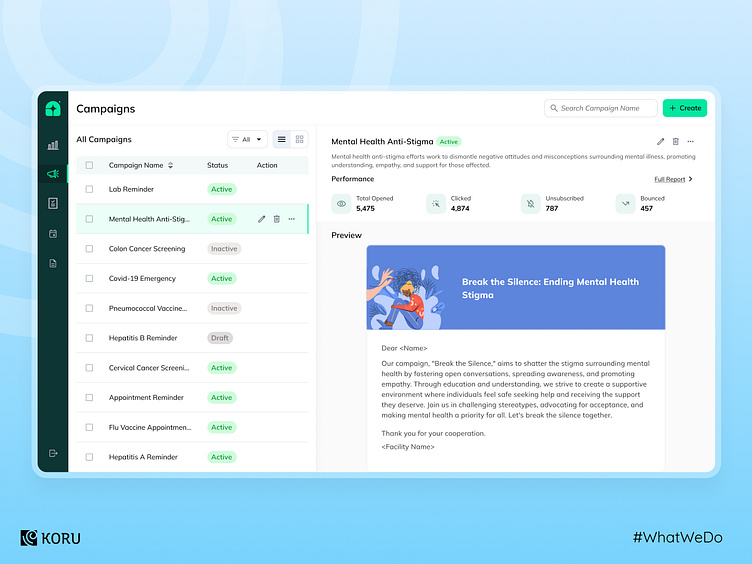Patient Outreach Platforms: Key Element of Preventive Healthcare
Patient outreach programs are designed to educate or remind patients about preventive care or treatment adherence. Effective patient outreach involves targeted campaigns based on specific criteria to deliver relevant messages and educational materials. A multi-channel approach (email, SMS, patient portal) has proven most effective in achieving healthcare goals. Therefore, their UI design should prioritize clear messaging, targeted content delivery, and easy access to additional resources.
1. Enable campaign tracking
A feedback mechanism helps gather input from patients about their experience with the outreach campaign. Feedback can help identify areas for improvement and ensure that future campaigns are more effective and user-friendly.
In the above UI, the campaign overview displays a list of all campaigns, with a toggle to display only the active ones. When a campaign is selected, it displays the various performance metrics and a preview of the content.
2. Simplify communication in outreach campaigns
The campaign form builder seen above helps build a form-based survey to be run within a campaign. Users can select from a list of pre-defined responses from the options and set up the survey with ease.
Make sure to tailor the outreach messages to each patient's needs and preferences whenever possible. Personalization can increase engagement and effectiveness by making patients feel valued and understood.
3. Designing clear, actionable surveys
This survey is designed for screening a patient prior to their appointment. The survey can be taken through a link sent as a message. The patient has to fill out their personal details, or tap on pills for pre-designated responses.
There is a search bar for patients to make it easy to use the right terms while reporting their symptoms. The patient receives a notification upon successful submission immediately and via email.
Provide clear instructions and actionable information in the outreach materials. Patients should understand what steps they need to take next, whether it's scheduling an appointment, accessing resources, or following up with healthcare providers.
4. Create effective follow-ups
The post-discharge follow-up workflow highlights the cases where the communication attempts have failed or gone unanswered. The list also displays the reason for admission and the discharge date for easy reference. The top panel displays the duration of the post-discharge engagement, the number of active and completed patient counts, and the overall engagement score.







